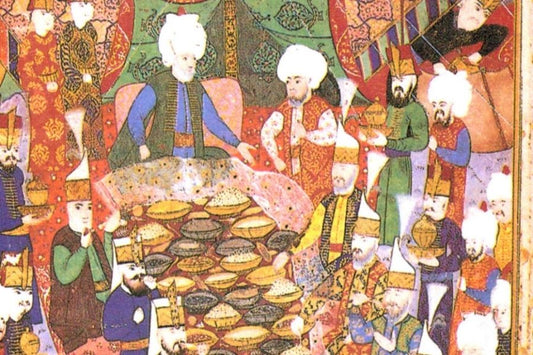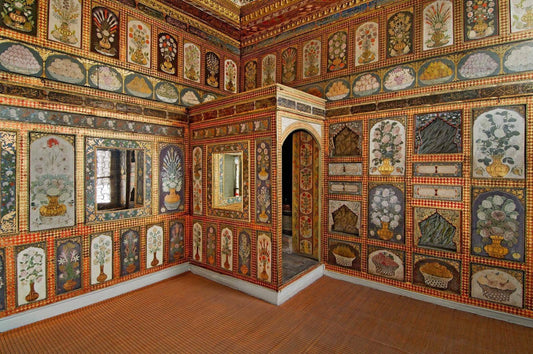The rose holds a special place in the worlds of art, literature, and faith, thanks to its beauty, fragrance, and meaning. From mythology to art, literature to religious beliefs, the rose motif has been used as a symbol of love, grace, and spirituality in many areas. Attributed to goddesses in ancient Greek and Roman mythology, the rose became an indispensable part of gardens and art in the Ottoman Empire. Rose patterns were frequently used in Iznik tiles, Ottoman art, manuscripts, and Quranic decorations. Furthermore, in the Islamic world, the rose, considered a symbol of the Prophet Muhammad, has become one of the most valuable motifs in religious art.
Cultural and Mythological Origins of the Rose
Throughout history, the rose has symbolized love, beauty, and elegance. In ancient Greek and Roman mythology, the rose was associated with goddesses and considered sacred. In Greek mythology, the goddess of flowers, Chloris (Flora in Roman mythology), transformed a nymph she found in the forest into a rose. Aphrodite gave her beauty, Dionysus his fragrance, and Apollo his light. In Roman mythology, white roses were believed to bloom in the birthplace of Venus.
The Meaning of the Rose in Literature and Art
The rose holds a significant place in Turkish literature and Ottoman art. The love between the nightingale and the rose is frequently depicted in the masnavis, and in Ottoman poetry, the rose has become a symbol of love, elegance, and spiritual affection. In Sufism, the rose motif represents the Prophet Muhammad. Therefore, rose patterns and rose figures carry religious and cultural significance in Ottoman art.
The Rose Motif from Ancient Times to the Ottoman Empire
Since ancient times, roses have been cultivated and traded in various regions for not only their beautiful appearance but also their fragrant oil. The oldest depiction of a rose appears in the blue bird fresco of the Palace of Knossos on the island of Crete, dating from 1550-1450 BC. Considering that the rose was so important that it was minted as the city's symbol on Rhodes coins during the Hellenistic period, rose cultivation must have been widespread on the island. During the Roman period, roses were used in funeral and wedding ceremonies, as well as in mosaic and fresco decorations. In Ottoman decorative art, the rose held a prominent place in many areas, from architecture to tile art.
Roses in Ottoman Gardens and Palaces
Rose gardens were of great importance in Ottoman palaces. Various varieties of roses were carefully cultivated in special areas called "gülhane" (rose gardens) in the palaces of Istanbul and Edirne. A portrait of Mehmed the Conqueror smelling a rose is one of the most important examples demonstrating the artistic and cultural value of roses in the Ottoman Empire.
Rose in Iznik Tiles and Traditional Arts
The rose was one of the most frequently used floral motifs in Ottoman tile art. The stylized rose pattern, developed by the 16th-century muralist Kara Memi, frequently appears on İznik tiles. Layered roses, particularly in İznik tile motifs, became a symbol of Ottoman decorative art. Roses in bloom on tiles are recognizable by their leaves and buds, and are detailed.
The Rose in the Quran and Religious Arts
The rose holds a prominent place in Islamic art and religious ornamentation. In manuscript Qurans, the symbols for sect, section, and prostration are called "rose." Narratives of the Prophet Muhammad praising the rose as the "lord of the flowers of heaven" have led to the rose motif's inclusion in religious art. In Ottoman art, the rose pattern was frequently used in calligraphy and illumination.
Contemporary Reflections of the Rose Motif
The rose motif has a wide range of uses, from traditional decorative arts to modern designs. Ottoman-era Iznik tile patterns continue to inspire contemporary art and decoration. Used in a wide range of applications, from interior design to ceramic ornamentation, the rose remains a classic symbol in art.
The Rose Motif: The Aesthetic Symbol of Art and Faith
The rose has been one of the most important symbols of art, literature, and religious beliefs throughout history. From antiquity to Ottoman art, from literature to tile decoration, the rose motif has been an expression of elegance, love, and spirituality. Holding a special place in Ottoman art, including İznik tiles and calligraphy, the rose pattern has also gained aesthetic and spiritual significance through its integration with religious beliefs. Today, this traditional motif continues to inspire tile art and decorative designs. If you wish to experience the elegance of traditional Ottoman art in your home, click here to explore our rose-motif tile designs.




